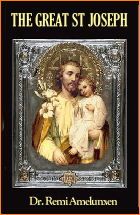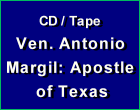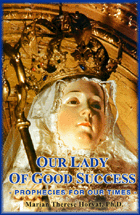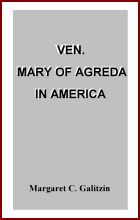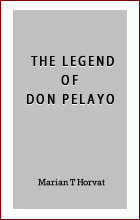American History
 |
 |
 |
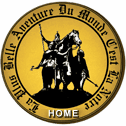 |
 |
 |
 |
California's Protomartyr - Part II
The Unknown Californian Martyr,
Fray Luis Jayme
The horrible night of the Indian assault on Mission San Diego had ended, as we saw in the last article, with a victory for the few soldiers and missionaries.
Early in the morning of November 5, Fray Fuster sent out some Indians to seek Fray Jayme.
The body of the 35-year-old missionary was recovered in the dry bed of the nearby creek and borne back to the Mission. He was naked except for his drawers, and his body was pitted like a sieve from the savage blows given him. His face was so disfigured that he could only be recognized by the whiteness of his flesh under a thick crust of congealed blood and the faint remains of a tonsure.
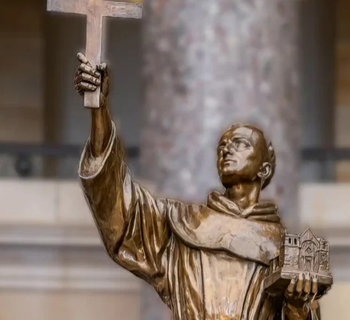 The reaction of the Franciscan Presidente to the news of his confrere’s death demonstrates the spirit of these early missionaries to the New World. Instead of tears and lamentations, Fray Junípero said: “Thanks be to God; now that the terrain has been irrigated by blood, the conversion of the San Diego Indians will succeed.” (1)
The reaction of the Franciscan Presidente to the news of his confrere’s death demonstrates the spirit of these early missionaries to the New World. Instead of tears and lamentations, Fray Junípero said: “Thanks be to God; now that the terrain has been irrigated by blood, the conversion of the San Diego Indians will succeed.” (1)
That proved a prophetic statement, for this was the sole uprising, and with the years, Mission San Diego, called the Mother of the Missions, came to be one of the most stable and prosperous in the Mission chain. In 1776, Padre Serra returned to the site and rebuilt the Mission, this time with a strong defensive wall. By 1797, more than 1,400 Indians had been baptized, and 55,000 acres were cultivated with vineyards, grain, fruit trees and vegetables. The Mission’s livestock counted 20,000 sheep, 10,000 cattle and more than 1,000 horses and mules.
By 1834 – when the Missions were secularized and confiscated by the Mexican government – the number of baptisms at that Mission had reached 6,522.
An extraordinary discovery on the mangled body
In his account of the massacre, Fray Serra records something extraordinary that all observed when the mangled body was found:
“When he was discovered the next day, there was not a sound spot on his body, save the consecrated hands. These God had preserved … in order that it might be known how zealously and nobly he had labored for the Indians who should repay him with such cruelty, and how he had toiled for the purpose of saving their souls and rescuing them from the gates of Hell.
“Nor do we doubt that he shed his blood willingly, in order to irrigate the vineyard of the Lord, which he had cultivated amid such hardships, and which, because of such copious irrigation, will yield fruit in season by converting the remainder of the pagans who as yet persist in their wild life. This we hope from the Lord through the intercession of the venerable deceased (Fray Luís Jayme), whose soul I do not doubt is now enjoying God.” (2)
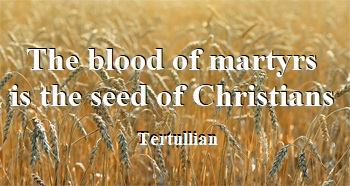 Father Serra later wrote that the character and manners of Fray Jayme had never ceased to be the subject of universal praise in life and in death. (3)
Father Serra later wrote that the character and manners of Fray Jayme had never ceased to be the subject of universal praise in life and in death. (3)
The Fray’s mangled body was taken to the Presidio chapel, where it was given temporary burial. When the new Mission church was completed, his body was exhumed and interred in its sanctuary. There it rested until November 12, 1813, when it was transferred to a third church. Today the remains of Fray Luís Jayme repose nearest the statue of the Blessed Virgin in a vault between the main altar and the side altar. One of the white stones on the cross on the floor bears his name, and a candle burns continuously there in memory of California’s first Martyr.
An unknown hero who merits recognition
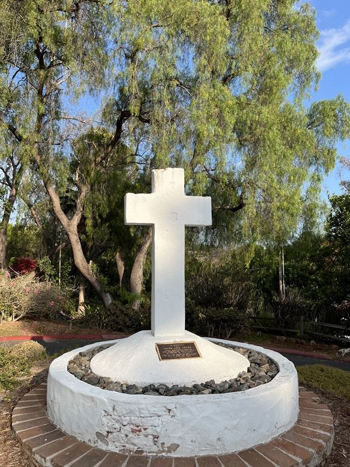 Many pilgrims have remarked on the peace and silence that pervades the Californian Missions, portals backward in time to a more simple and stable world. An especially profound sense of transcendence rests on a site with a white stone Cross on the north site of San Diego Mission grounds, the place where California’s first Martyr was taken and then dragged away to be cruelly massacred during that Indian uprising on November 5, 1775. (4)
Many pilgrims have remarked on the peace and silence that pervades the Californian Missions, portals backward in time to a more simple and stable world. An especially profound sense of transcendence rests on a site with a white stone Cross on the north site of San Diego Mission grounds, the place where California’s first Martyr was taken and then dragged away to be cruelly massacred during that Indian uprising on November 5, 1775. (4)
There is a sign with an inscription giving a brief history of Padre Luis Jayme, the Protomartyr of California. (5) But his name is relatively unknown, his intercession rarely invoked. His remains are buried in San Diego Basilica, but most Catholics pass by this holy place without recognizing his name or significance.
The village where he was born in Majorca has paid him greater honor than the paltry notice given him in the land where he shed his blood. In San Juan, Majorca, a large stone statue of the Martyr sets above the Town Centre; a monument was constructed to commemorate the bicentennial of his martyrdom, and a large painting was commissioned for the sacristy of St. John’s Church where he was baptized.
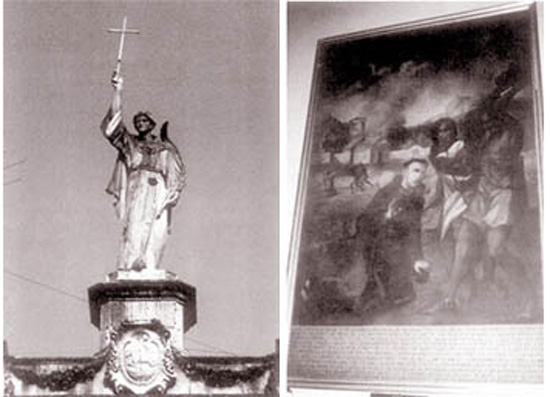 Yet, from Heaven, Padre Luis Jayme regards with special attention the Missions of California, the land he evangelized and irrigated with his blood. It seems only natural that we should call upon him in these dismal days to strengthen our faith and make us intransigent against the attacks of the enemy, both within and outside the walls of the Holy Church.
Yet, from Heaven, Padre Luis Jayme regards with special attention the Missions of California, the land he evangelized and irrigated with his blood. It seems only natural that we should call upon him in these dismal days to strengthen our faith and make us intransigent against the attacks of the enemy, both within and outside the walls of the Holy Church.
Let us, then, come to know him better and tell others of his heroic life so that we might all have recourse to him in our fight to restore Christian Civilization in these neo-pagan days.

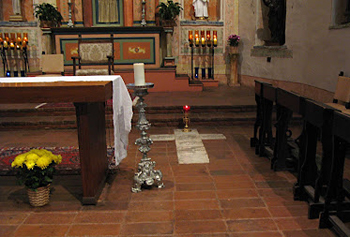

The body of the 35-year-old missionary was recovered in the dry bed of the nearby creek and borne back to the Mission. He was naked except for his drawers, and his body was pitted like a sieve from the savage blows given him. His face was so disfigured that he could only be recognized by the whiteness of his flesh under a thick crust of congealed blood and the faint remains of a tonsure.

The statue in San Juan, Majorca atop the city hall honoring the California Martyr
That proved a prophetic statement, for this was the sole uprising, and with the years, Mission San Diego, called the Mother of the Missions, came to be one of the most stable and prosperous in the Mission chain. In 1776, Padre Serra returned to the site and rebuilt the Mission, this time with a strong defensive wall. By 1797, more than 1,400 Indians had been baptized, and 55,000 acres were cultivated with vineyards, grain, fruit trees and vegetables. The Mission’s livestock counted 20,000 sheep, 10,000 cattle and more than 1,000 horses and mules.
By 1834 – when the Missions were secularized and confiscated by the Mexican government – the number of baptisms at that Mission had reached 6,522.
An extraordinary discovery on the mangled body
In his account of the massacre, Fray Serra records something extraordinary that all observed when the mangled body was found:
“When he was discovered the next day, there was not a sound spot on his body, save the consecrated hands. These God had preserved … in order that it might be known how zealously and nobly he had labored for the Indians who should repay him with such cruelty, and how he had toiled for the purpose of saving their souls and rescuing them from the gates of Hell.
“Nor do we doubt that he shed his blood willingly, in order to irrigate the vineyard of the Lord, which he had cultivated amid such hardships, and which, because of such copious irrigation, will yield fruit in season by converting the remainder of the pagans who as yet persist in their wild life. This we hope from the Lord through the intercession of the venerable deceased (Fray Luís Jayme), whose soul I do not doubt is now enjoying God.” (2)

Hearing of Padre Jayme’s death, Padre Serra recalled the words of Tertullian
The Fray’s mangled body was taken to the Presidio chapel, where it was given temporary burial. When the new Mission church was completed, his body was exhumed and interred in its sanctuary. There it rested until November 12, 1813, when it was transferred to a third church. Today the remains of Fray Luís Jayme repose nearest the statue of the Blessed Virgin in a vault between the main altar and the side altar. One of the white stones on the cross on the floor bears his name, and a candle burns continuously there in memory of California’s first Martyr.
An unknown hero who merits recognition

The place outside the Mission grounds near the back parking lot marks where Fray Jayme was massacred
There is a sign with an inscription giving a brief history of Padre Luis Jayme, the Protomartyr of California. (5) But his name is relatively unknown, his intercession rarely invoked. His remains are buried in San Diego Basilica, but most Catholics pass by this holy place without recognizing his name or significance.
The village where he was born in Majorca has paid him greater honor than the paltry notice given him in the land where he shed his blood. In San Juan, Majorca, a large stone statue of the Martyr sets above the Town Centre; a monument was constructed to commemorate the bicentennial of his martyrdom, and a large painting was commissioned for the sacristy of St. John’s Church where he was baptized.

In Fray Jayme’s town in San Juan, Majorca, two memorials honor the martyr: a statue atop the town’s City Hall & a painting in St. John the Baptist Church
Let us, then, come to know him better and tell others of his heroic life so that we might all have recourse to him in our fight to restore Christian Civilization in these neo-pagan days.

The martyr’s remains are buried in the sanctuary;
a candle burns continuously on the site to honor his memory

- Fr. Zephyrin Engelhardt, OFM, San Diego Mission, San Francisco: James H. Barry Co, 1920, p. 68.
- Ibid., p. 64
- Maynard Griger, The Life and Times of Junípero Serra, Vol. II, Washington: Academy of American Franciscan History, p. 114
- The cross commemorating California’s first martyr Padre Luís Jayme is on San Diego Mission Road. See map here.
- The inscription reads: Born Melchor Jayme on October 18, 1740, in the farming village of San Juan, Majorca, Spain. In 1760, he was received into the Franciscan Order and chose "Luis" as his religious name. Padre Jayme became pastor of Mission San Diego in 1771 and was instrumental in moving the Mission inland from the Presidio to the present site in August of 1774. By December of that year, number of adobe and thatch buildings were constructed. Crops were planted and many natives joined the Mission life and were baptized as Christians.
Progress was being made until the early morning hours of November 5, 1775, when hundreds of natives from remote villages set fire to the Mission Buildings, pillaged the church and cruelly murdered Padre Jayme as he met them with his usual greeting, "¡Amar a Dios, hijos! - Love God, my children!"
Padre Jayme became California's first Christian martyr because of his self-sacrifice, devotion, faith and love. His remains are buried in the sanctuary of the church at Mission San Diego de Alcalá.

Posted July 28 2025
______________________
______________________



